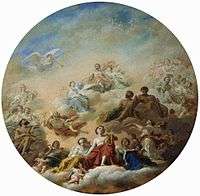Nikolay Maykov
| Nikolay Apollonovich Maykov | |
|---|---|
|
Self-portrait (1830s) | |
| Native name | Николай Аполлонович Майков |
| Born |
August 28, 1794 Moscow, Russia |
| Died |
August 23, 1873 (aged 78) Saint Petersburg, Russia |
| Known for | Painting |
| Style | Portrait, history and religious |
Nikolay Apollonovich Maykov (Russian: Николай Аполлонович Майков; 28 August 1794, Moscow - 23 August 1873, Saint Petersburg) was a self-taught Russian portrait, history and religious painter in the Academic style.
Biography
His father, Apollon Alexandrovich Maykov, was a poet, State Counsellor and Director of the Imperial Theaters. In 1801, he was sent to Saint Petersburg to train and study with the Second Cadet Corps,[1] but had not completed his courses at the time of the French Invasion in 1812. He was mustered into the Army as an officer, under the command of General Pyotr Bagration, and fought at the Battle of Borodino, where his leg was pierced by a bullet.
He went to his father's estate near Yaroslavl to recuperate. While there, he taught himself drawing to pass the time. After his recovery, he rejoined the Army to pursue Napoleon's retreating forces. During the pursuit, he made sketches whenever there was a pause in the action; all the way through Poland and Germany, into France.[1] While in Paris, he tried his hand at oil painting and wanted to study in Italy, but his father would not provide the necessary support, so he returned to Russia, retired with the rank of Major and settled in Moscow, where he married and started a family.[2]

He tried to improve his skills by copying famous paintings at the museums there,[2] then moved to Saint Petersburg, so he could have access to the works at the Hermitage. Museum patrons were impressed with his work and he eventually attracted the notice of Tsar Nicholas I. On the Tsar's behalf, he created a series of images for the Trinity Cathedral. As a result, the Imperial Academy of Arts named him an "Academician" in 1835 and, on the Tsar's orders, was admitted as a member.[1]
For over ten years, he worked on an iconostasis at Saint Isaac's Cathedral. He also created works at smaller churches throughout the region, as well as in chapels at the Winter Palace and the Yelagin Palace.[1] He also did murals at private residences; notably at a mansion belonging to Yusupov family; now home to the St. Petersburg Institute of International Trade, Economics and Law. During these projects, he also made portraits of the aristocracy and other notables.
His sons were all accomplished:[2] Apollon was a poet; Valerian was a literary critic; Vladimir was a publisher (notably of children's books); Leonid was a literary scholar and ethnographer.
References
- 1 2 3 4 Brief biography @ RusArtNet.
- 1 2 3 Brief biography @ Russian Paintings.
Further reading
- Natalya Volodina, Майковы, "Tales of Russian Families" series, Nauka, 2003 ISBN 5-02-026847-X
External links
![]() Media related to Nikolai Maykov at Wikimedia Commons
Media related to Nikolai Maykov at Wikimedia Commons

